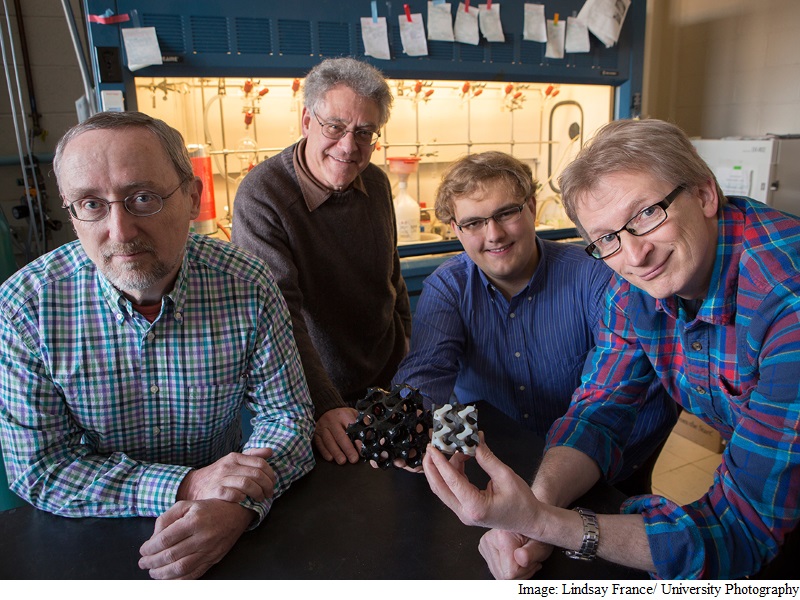- Home
- Science
- Science News
- Researchers Create First Self Assembled, Three Dimensional Superconductor
Researchers Create First Self-Assembled, Three-Dimensional Superconductor

It is the first time a superconductor, in this case niobium nitride (NbN), has self-assembled into a porous, 3D gyroidal structure, said lead researcher Ulrich Wiesner, a materials science and engineering professor.
The gyroid is a complex cubic structure based on a surface that divides space into two separate volumes that are inter-penetrating and contain various spirals.
"We are saying to the superconducting community, 'Hey, look guys, these organic block copolymer materials can help you generate completely new superconducting structures and composite materials, which may have completely novel properties and transition temperatures. This is worth looking into,'" Wiesner said.
The findings appeared in the journal Science Advances.
Currently, superconductivity for practical uses such as in magnetic resonance imaging (MRI) scanners and fusion reactors is only possible at near about -273 degrees Celsius, although recent experimentation has yielded superconducting at a comparatively balmy -70 degrees Celsius.
"There is this effort in research to get superconducting at higher temperatures, so that you do not have to cool anymore," Wiesner said.
"That would revolutionise everything. There is a huge impetus to get that," Wiesner explained.
In the first attempt to achieve superconductivity, the niobium oxide was heated to a temperature of 700 degrees Celsius.
After cooling the material to room temperature, it was determined that superconductivity had not been achieved. The same material was then heated to 850 degrees, cooled and tested, and superconductivity had been achieved.
"We tried going directly to 850, and that did not work," Wiesner said.
"So we had to heat it to 700, cool it and then heat it to 850 and then it worked," Wiesner noted.
Get your daily dose of tech news, reviews, and insights, in under 80 characters on Gadgets 360 Turbo. Connect with fellow tech lovers on our Forum. Follow us on X, Facebook, WhatsApp, Threads and Google News for instant updates. Catch all the action on our YouTube channel.
- Samsung Galaxy Unpacked 2025
- ChatGPT
- Redmi Note 14 Pro+
- iPhone 16
- Apple Vision Pro
- Oneplus 12
- OnePlus Nord CE 3 Lite 5G
- iPhone 13
- Xiaomi 14 Pro
- Oppo Find N3
- Tecno Spark Go (2023)
- Realme V30
- Best Phones Under 25000
- Samsung Galaxy S24 Series
- Cryptocurrency
- iQoo 12
- Samsung Galaxy S24 Ultra
- Giottus
- Samsung Galaxy Z Flip 5
- Apple 'Scary Fast'
- Housefull 5
- GoPro Hero 12 Black Review
- Invincible Season 2
- JioGlass
- HD Ready TV
- Laptop Under 50000
- Smartwatch Under 10000
- Latest Mobile Phones
- Compare Phones
- Redmi Note 15 5G
- Redmi Note 15 Pro 5G
- Redmi Note 15 Pro+ 5G
- Lava Play Max
- Poco C85 5G
- Honor Magic 8 Lite
- Jolla Phone
- Realme P4x 5G
- Asus ProArt P16
- MacBook Pro 14-inch (M5, 2025)
- OnePlus Pad Go 2
- Poco Pad M1
- Just Corseca Skywatch Pro
- Honor Watch X5
- Acerpure Nitro Z Series 100-inch QLED TV
- Samsung 43 Inch LED Ultra HD (4K) Smart TV (UA43UE81AFULXL)
- Asus ROG Ally
- Nintendo Switch Lite
- Haier 1.6 Ton 5 Star Inverter Split AC (HSU19G-MZAID5BN-INV)
- Haier 1.6 Ton 5 Star Inverter Split AC (HSU19G-MZAIM5BN-INV)












